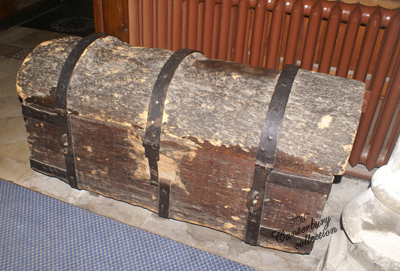
![]()
~ ST. DUNSTAN'S CHURCH ~
ST. DUNSTAN'S STREET, CANTERBURY
St. Dunstan's Church belonged to the Convent of St. Gregory in Canterbury
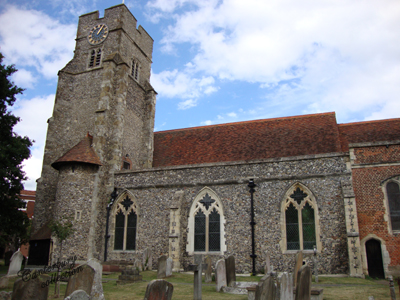
Restored in 1878-9
Register of baptisms dates from 1574, marriages 1561 and burials 1559
St. Dunstan's Parish Records available at the Canterbury Cathedral Archives (1485-1995)
Accounts of the Churchwardens of St. Dunstan's, Canterbury, A.D. 1484 - 1580, Reprinted for private circulation, from "Archaeologia Cantiana," 1886 J. M. Cowper
The Register Booke of Christenings Marriages and Burialls in Saint Dunstan's, Canterbury 1559 - 1800, 106 Copies privately printed, 1887 J. M. Cowper
St. Dunstan's Church, Canterbury some MI's by the Rev. Bryan Faussett on kentarchaeology.org.uk
There was a chauntry founded in St. Dunstans church by John ROPER, for two priests to celebrate at the altar of St. Nicholas in that church. Pat. 4. Hen. 4. parte prima, Memb. 29
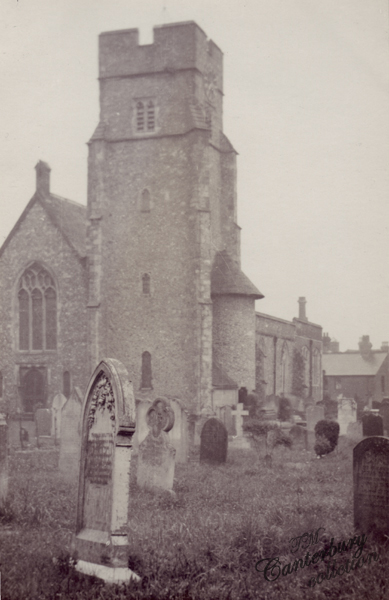 _____
_____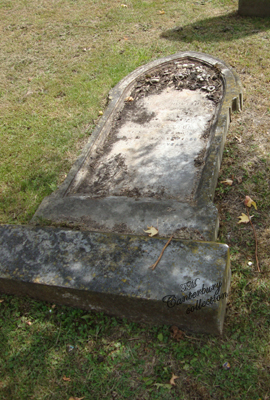
An old photo postcard of the church and graveyard from my collection
The colour photo is of the tombstone now that is in the black & white photo above left, the tombstone was toppled over and covered in grass. The stone reads:
THOMAS HOLTTUM
DIED 18 NOVEMBER 1898
IN HIS 67th YEAR
HIS END WAS PEACE
ELIZA HOLTTUM
WIFE OF THE ABOVE
DIED 5th NOVEMBER 1899
IN HER 82nd YEAR
*thanks to Tricia for this above
write-up
In a two light stained glass window, on the North side of the Chancel:
"To the memory of Edward and Sarah Holttum erected by their only surviving son Charles Holttum. F.R.C.S.E."
*Edward Holttum died in 1869, aged 75; Sarah his wife died in 1865 aged 73. Both were buried in St. Dunstan's Churchyard.
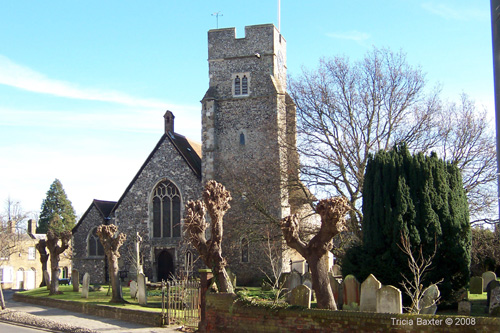
"Founded by Archbishop Lanfranc towards the end of the eleventh century, was formerly one of the most important of the Canterbury churches. It has an unusual semi-circular tower adjoining the square Western tower on the Southern side, and contains some notable monuments of the Roper family. In the Roper vault is still preserved the head of Sir Thomas More, whose daughter Margaret married one of the Ropers. Hither to St. Dunstan's in 1174 come Henry II, King of England, on his famed pilgrimage to the shrine of St. Thomas of Canterbury. Having entered the church and partly striped, he donned the hair shirt and cloak of a pilgrim, and walked barefoot to the Cathedral. The wealth of the Canterbury churches in pre-Reformation days may be gathered from an inventory still existing of the treasures belonging to St. Dunstan's in 1500. These include angels of ivory and of burnished gold, chalices and other vessels of silver, precious stones and vestments, books, banners, bells, and other ecclesiastical garniture of enormous value."
Handbook for Canterbury, British Association Dover 1899
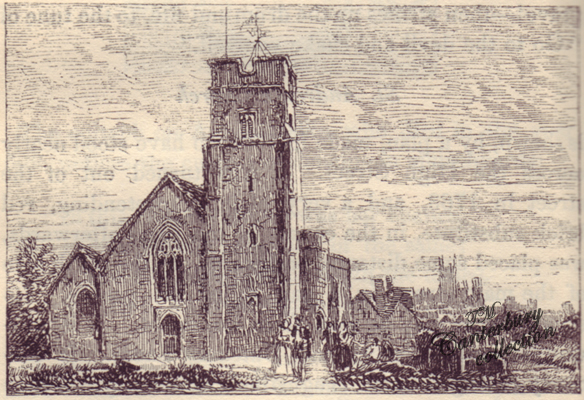
"ST. DUNSTAN'S CHURCH" drawing from Felix Summerly's Hand-book to the City and the Cathedral 1843
On arriving by the London Road, the church of St. Dunstan meets you in the suburb; and on crossig the threshold of hte city, to the right hand of old Westgate, and almost touching it, you have the still more ancient church of the Holy Cross. St. Dunstan's, which stands on gently rising ground belonged to the Convent of St. Gregory in Canterbury. Its most marked architectural feature is a semicircular tower adjoining the western square tower. The church has suffered much from the barbarism of the last century; but it was four or five years back much improved by the incumbent, the Rev. B. B. Bunce, who removed most of the whitewash daubing which spoiled the interior. And here we may say that, generally, the clergy of the present day have shown, and are showing, a laudable desire to make up for the want of taste and want of liberality of their predecessors.
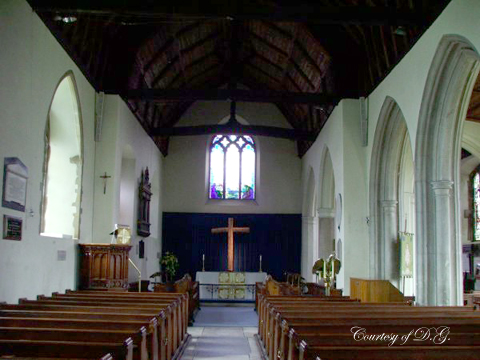
What is now the vestry room was once a little chapel, founded by one Henry, the king's chaplain in 1330. There are two altar tombs of Bethersden marble, and these belonged to the family of the Ropers, who in the time of Henry IV. founded the chapel where they are placed; and below your feet, in the family vault of the Ropers still lies the head of Sir Thomas More. That great man's beloved daughter Margaret, it will be remembered, married one of the Ropers, who afterwards wrote that well known account of the sayings and doings of the great and honest Chancellor of Henry VIII. which is one of the most delightful pieces of biography to be found in any language or any period. It had been upon record that the head of More had been placed here "with great devotion", by his daughter Margaret Roper; but people had almost forgotten the fact, when in the year 1835, the chancel of the church being newly paved, this Roper vault was opened, and several persons descending into it, there saw a head which had evidently been severed from the body. It was in a niche in the wall, in a leaden box, something of the shape of a bee-hive, open in the front, with an iron grating before it. Thus reported a correspondent of the Gentlemen's Magazine, in which work (in the number for May, 1837) may be found proofs which identify this skull with the once brilliant witflashing head of Sir Thomas More. Knight's Excursion Companion
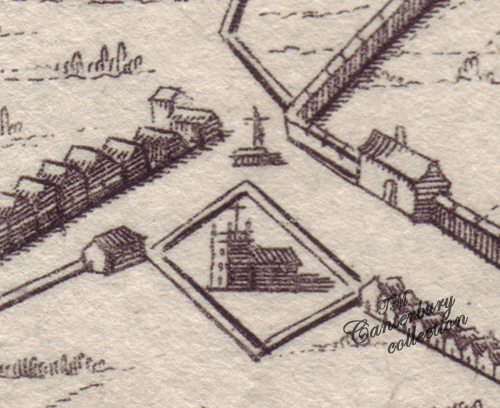
Detail from a 17th century map in my collection, showing St. Dunstan's church
"On Friday, July 8, 1574, Henry approached Canterbury, stripped off his ordinary dress at the entrance to the city from the London road, in a chapel of the church of St. Dunstan, and walked through the streets barefoot, only clad in a woolen shirt with a cloak thrown over it as a slight protection from the rain which was pitilessly falling."
From Canterbury A history of the ancient city, written by J. Charles Cox
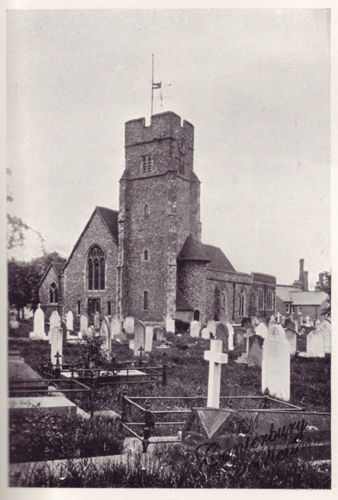
"St. Dunstan's is situated near the entrance of the City, on the London Road, and consists of a spacious nave and chancel, with a small chapel opening to the latter by plain pointed arches springing from ornamented columns: at the north-west angle is a square tower. In his Church was a Chantry for two chaplains, founded in the reign of Henry the Fourth, by John Roper, Esq. whose family had long been seated at PLACE-HOUSE, or St. Dunstan's Place, in this Parish, and from a younger branch of whom descended the Ropers, Lords Teynham. In the vault beneath the Chantry Chapel many of this family are deposited: and here also is preserved the Scull* of the celebrated Sir Thomas Moore, whose favorite daughter, Margaret, was married to William Roper, Esq. and is also interred here. She is stated to have secretly procured the head of her father after its exposure on London Bridge, and to have kept it by her to the time of her death, after which it was placed near her coffin, in a niche in the wall, secured by an iron grate. In the Chapel are several monuments of the Ropers, together with a helmet, sword, tabard, and other trophies."
The Beauties of England and Wales, 1808 *yes it's spelt like this
 __
__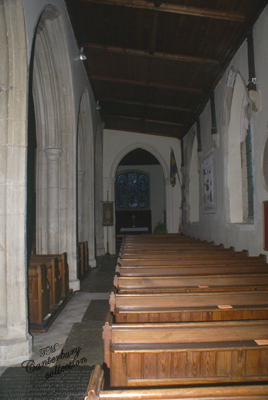
"St. Dunstan's Church is an ancient structure, on elevated ground, at the western extremity of St. Dunstan's street. It consists of nave, south aisle, and two chancels, with a square tower at the west end, adjoining which is a semi-circular tower at its southern side. The little chapel at the north-west corner, now used as a vestry room, was founded by one Henry, the King's chaplain in 1330, and dedicated by him to the Holy Trinity. In the south-east chancel are two altar toms, of Bethersden marble, erected to the Roper family, who in the reign of Henry IV. founded the chancel where they are placed. Of such consequence was this family, that two chaplains were here statedly employed at a salary of 8 pounds per annum, to pray for the souls of such of the family as were dead, and for the prosperity of those who were living. The most interesting memorial connected with this church, is the fact that the family vault of the Ropers contains the skull of the upright and consistent Chancellor, Sir Thomas More. After his head had been exhibited on a pole on London Bridge, his daughter obtained possession of it, and preserved it in a casket, until her death, when it was placed beside her coffin, in this church. The chancel being newly paved in 1835, the Roper vault was opened, and several persons descended into it, when the skull was found still remaining in the place where it was seen many years ago, in a niche in the wall, in a leaden box, something of a shape of a bee-hive, open in the front, and with an iron grating before it.
|
"Ancient Communion table" Drawing from my Canterbury a history of the Ancient City |
|
The communion table
is of walnut wood and curious from its being made to lengthen
out at will like a dining table, it formerly stood on wheels.
Kelly's Directory of Kent, 1882
|
The font, covered with an antique canopy of Gothic carved work, a very old monument chest, and an ancient communion table of walnut, are the only relics of antiquity besides a few gravestones stripped of their brasses."
Directory 1847
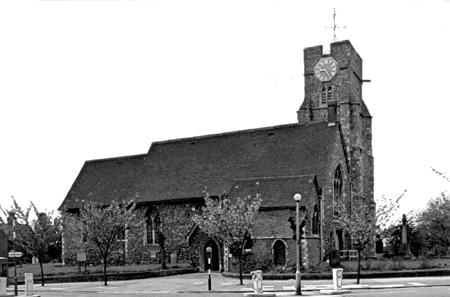

St. Dunstan's Canterbury, March 12, 1837
"As I have observed in your excellent Magazine, that a few years ago the public had taken a deep interest in the restoration of Sir Thomas More's monument in the Church of Chelsea, the place which was destined by the excellent and amiable man for the interment of his body, but which is in fact an empty cenotaph*, I trust that less will not be felt by many of your readers for the spot where his head was placed; which was obtained (after its exposure on London Bridge) by his beloved daughter Margaret, and brought to her residence in St. Dunstan's, Canterbury, and deposited, by her request, in the same vault with her after her decease.
In the chancel of the church is a vault belonging to that family, which, is newly paving of the chancel, in the summer of 1835, was accidentally opened; and, wishing to ascertain whether Sir T. More's scull was really there, I went down into the vault, and found it still remaining in the place where it was seen many years ago, in a niche in the wall, in a leaden box, something of the shape of a bee-hive, open in the front and with an iron grating before it. In this vault were five coffins, some of them belonging to the Henshaw family, one much decayed, no inscription to be traced on it. The wall in the vault, which is on the south side, and in which the scull was found, seems to have been built much later than the time of Sir T. More's decapitation, and appears to be a separation between the Roper chancel and the part under the Communion Table.
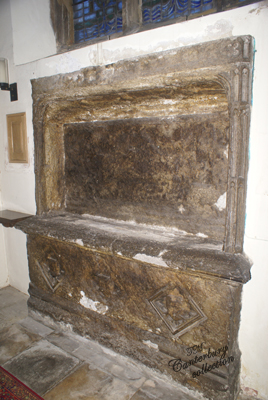
There are two Altar tombs of Bethersden marble, and these belonged to the family of the Ropers, who in
the time of Henry IV. founded the chapel where they are placed; near and below is the family vault of the Ropers
where the head of Sir Thomas More supposebly lies.
In the same chancel are two venerable altar tombs, of Betherden marble, one of them, partly within an arch in the wall, which was probably that of the founder of the chancel, and from both of which, brasses have evidently been removed*; and over them is a surcoat with a helmet surmounted by the crest of the eagle and child. There were, when I first knew the church, three small banners waving over them, which were so completely in rags and decayed, that they not many years ago fell to pieces.
*the brasses were gone as early as 1758 when Bryan Faussett noted the monuments
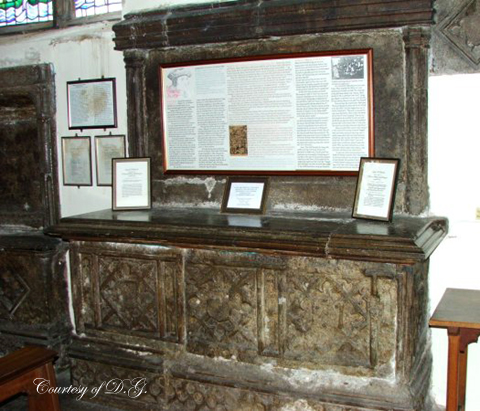
There are two Altar tombs of Bethersden marble, and these belonged to the family of the Ropers, who in
the time of Henry IV. founded the chapel where they are placed; near and below is the family vault of the Ropers
where the head of Sir Thomas More supposebly lies.
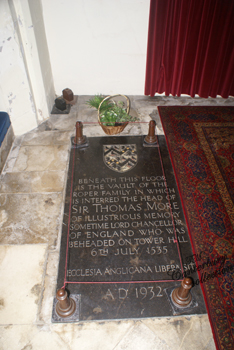
Opposite to these tombs is a beautiful monument, erected by a grandson of Sir T. More sacred (as he calls it) "PIETATI ET PARENTIBUS:" it has been lately cleansed from the dust and cobwebs of ages, and stands forth now in all its former chasted and simple beauty.
This venerable church consists of two aisles and two chancels at the east end, which is used as a vestry. There is a plain octagonal font, now placed under the belfry tower, of a very early date, with a canopy, or top, of oak, beautifully carved and highly ornamented with crockets.
In musing over these relics of days gone by, and connected as they are both above and below ground with that simple-minded an pious martyr, I could not but feel that I was treading on religious classic ground, and hope that a similar good feeling might induce some, who venerate the great and the good of other times, to manifest the same laudable wish to save from ruin the sacred walls which contain the head, as they have done in restoring the empty monument of that excellent man. I enter con amore into restorations of this sort, I have been planning how it might be done with best effect; and it has struck me that the eastern window of the chancel might be ornamented with a copy of that beautiful bust of Sir T. More by Holbein, and in the side lights might be placed the coats of arms of the different compartments by handsome small oaken beams, might be restored, and shields placed at the intersections of the angles; and a Gothic open screen of the same wood might surround the chancel. As a finish to the whole, I would have a handsome small vase of Bethersden Marble, standing on a plain circular pillar, erected under the window; in which I would place, if it was not thought improper, the scull itself, with a suitable inscription. But the difficulty is, HOW is all this to be accomplished? I see no other possible way, than some of the descendants of Sir Thomas paying this sacred debt (may I call it?) to the memory of their great and good ancestor, or by others not connected with the family, but who take a deep interest in matters of this sort; doing, in short, as your Magazine records they have been lately been doing at Chelsea, and paying the same mark of respect to the head in St. Dunstan's church, as they have there done to his empty tomb. I have known this church for nearly forty years, and feel a strong wish to see it put into complete order. There is a great capability about it for making it one of the best churches in Canterbury; and I cannot but hope and trust that such may be effected at no distant period; for evidently there seems to be a wish in the parish to improve this sacred edifice; but, alas! their means are inadequate. I am glad, however, to observe, that lately they have put in a beautiful painted window over the altar screen, consisting of three lights, the figure of the Redeemer in the centre, and the emblems of the Evangelists on each side, with a radiated I. H. S. surrounded by a crown of thorns. They have also made a baptistry with a neat little lancet-shaped window, of painted glass, also consisting of a Dove, descending on the Cross, under which appears the Lamb and an Infant St. John; and in it is placed the venerable old Font, which I mentioned before.

As I see, from your devoting many pages to accounts of churches and every thing belonging to them worthy of attention, that you interest yourself much in matters of this sort, I hope you will be able to make room, in some early number, for this notice of St. Dunstan's church; and should it be the means of calling the attention of any antiquary to this subject, it will afford much satisfaction to the writer, that he has been in some degree instrumental to the marking more particularly the place where it rests the head of one who marked no inconsiderable a figure in the history of the reign of the Eighth Henry, and who fell a victim to the jealousy of that tyrant, by so boldly refusing to acknowledge the supremacy of his rule of the Church of England.
Yours, &c. V.S.D. (*I assume this is Vicar St. Dunstans)
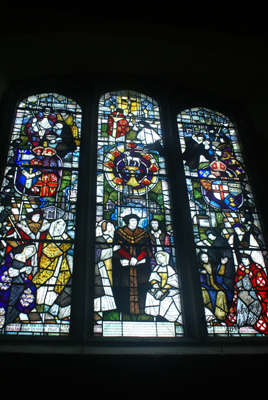 ___
___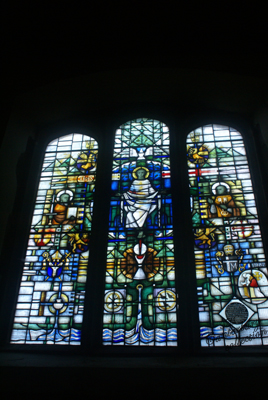
"In making lately some necessary repairs in St. Dunstan's church, Canterbury, a box was found, containing the head of the great Lord Chancellor More, who was condemned to the block by that ruthless King, Henry the VIIIth, for refusing to take the oath of supremacy to the self-willed Monarch. The head, with the exception of a few teeth, was much decayed; and the sacred remains have been restored to their resting place. Sir Thomas was beheaded on the 6th of July, 1535, in the 53d year of his age; after the execution, though the body was buried in the church of St. Peter, in the Tower, and afterwards in Chelsea church, where it now lies, yet his head was set on a pole upon London Bridge; and was afterwards privately bought by his daughter Margaret, wife of John Roper, esq. (a distinguished family long resident in the parish of St. Dunstan's.) His daughter preserved the head in a box, with much devotion, and placed it in a vault, partly in the wall on the south side of the church, where it was recently discovered, and very near to her own tomb. The south chancel of the church is called the Roper chancel and there hung the helmet and surcoat, with the arms of Sir. T. More on it." Sept 1824 NMM
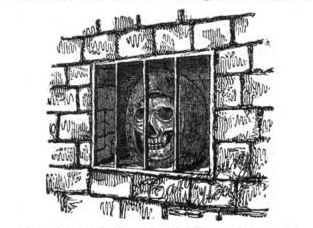
In illustration of the interesting disclosure made by this correspondent, we have made the following extracts from the several authors who have noticed the fate of the Head of Sir Thomas More. The first is from Cresacre More's Life of his illustrious ancestor (p. 289, Mr. Hunter's edit.):

"His head having remained about a month upon London-bridge, and being to be cast into the Thames, because room should be made for divers others, who in plentiful sort suffered martyrdom for the same Supremacy, shortly after, it was bought by his daughter Margaret, lest (as she stoutly affirmed before the Council, being called before them after for the same matter) it should be food for fishes; which she buried where she thought fittest; it was very well to be known, as well by the lively favour of him, which was not all this while in any thing almost diminished; as also by reason of one tooth, which he wanted whilst he lived; herein it was to be admired, that the hairs of his beard being almost grey before his martyrdom, they seemed now as it were redish or yellow."
The next is from Lewis's Preface to Roper's Life of Sir Thomas More (Singer's ed. p.xxi.):
"With this excellent woman Mr. Roper lived about 16 years, she dying 1544, nine years after her father, when she was buried in the family burying-place at St. Dunstan's with her father's head in her arms, as she had desired."
But still more precise, and doubtless more accurate, is the account given by Anthony a Wood in his Athenae Oxonienses (vol. i. p. 86, Bliss's edit.):
"As for his head, it was set upon a pole, on London-bridge, where abiding about 14 days, was then privily bought by the said Margaret, and by here for a time carefully preserv'd in a leaden box, but afterwards with great devotion 'twas put into a vault (the burying-place of the Ropers) under a chapel joyning to St. Dunstan's church in Canterbury, where it doth yet remain, standing in the said box on the coffin of Margaret his daughter buried there."
And lastly, as confirming the chain of proof as to the identity of the scull lately seen, the following note in the same place is very satisfactory:
"Dr. (then Mr.) Rawlinson informed Hearne, that when the vault was opened in 1715, to enter into one of the Roper's family, the box was seen enclosed in an iron grate."
The Gentlemen's Magazine 1837
*Gentlemen's Magazine, December 1833, pg. 485
**His body was interred in the chapel of the Tower of London
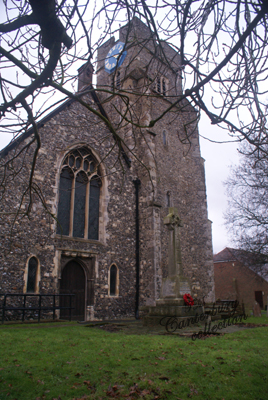
In St. Dunstan's Church, beyond, the head of Sir Thomas More was deposited in the vault of the Ropers. When examined some time since, the hair was found to be quite perfect. The brick gateway nearly opposite the church, now part of a brewery, is all that remains of the Ropers' manor-house, in which Margaret, the most learned of the "Moricae," as Erasmus called Sir Thomas's daughters, spent her married life.
A handbook for Travellers in Kent and Sussex 1858
"St. Dunstan church is larger and handsomer than most of the parish churches in our city, and its neighbourhood. In a vault under the family chancel of Roper here is kept a skull, said to be that of the great Sir Thomas More; it is in a niche of the wall, secured with an iron grate, though some say his favourite daughter, Margaret Roper, who lie here, desired to be buried with it in her arms. The vault being full, was closed up not many years since."
A walk in and about the city of Canterbury with many observations not to be found in any description hitherto published, the second edition, by William Gostling, M.A. 1777
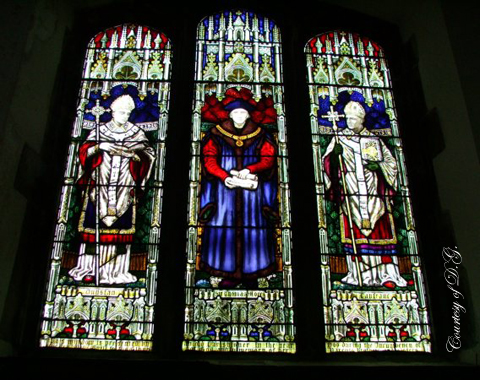
"The church of St. Dunstan's is one of the most interesting of the parish churches of Canterbury. It is outside the ancient boundaries of the city, but it has long been brought practically within it. It was one of the may foundations of Archbishop Lanfranc (1070-1089), who attached it to his Priory of St. Gregory in Northgate.
A century later the church formed a stage in the pilgrimage of the King of England to the shrine of St. Thomas. Henry had dismounted at Harbledown, and walked with his attendants to St. Dunstan's. Entering the church, the king partly stripped, put on the hair shirt and the cloak of the pilgrim, and walked barefooted to the Cathedral. The little Norman church became, no doubt, a place of some note in connection with the king's penance. Other pilgrims would be likely to follow Henry's example, and pause at St. Dunstan's before passing on their way into the city. The vicarage was established and endowed by Archbishop Reynolds in 1322, and during the same century, one Henry of Canterbury, a chaplain of the king, founded a chapel on the north side of the church, dedicating it to the Holy Trinity. He endowed there a perpetual chantry, which he gave in charge to the poor Priests' Hospital. This chantry was continued until the Reformation. It was not the only one, however, attached to the church, for we read that two chaplains were maintained by the Roper family to sing masses at the altar of St. Nicholas, for the souls of their dead. This family during several centuries, lived in the parish, and were buried in the church. It was a Roper who built the chancel aisle, known as the Roper Chancel. The family residence was at Place House, or St. Dunstan's Place, which stood opposite the churchyard, its site being at present occupied by the brewery of Messrs. Flint and Sons. Only the old gateway of the mansion remains.
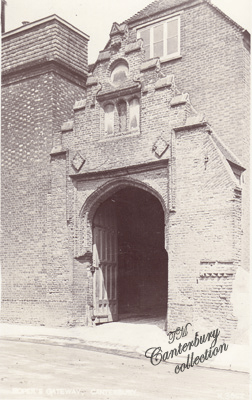
One William Roper, who resided there in the reign of Henry III was a great benefactor to St. Martin's Priory, Dover. The Ropers continued to be buried in the church till the elder male line became extinct, but their vault continued to receive members of the family down to 1741. Lord Teynham, a Roper-Curzon, is descended from a Christoper Roper, of the 16th century.
The chantries and masses, with their attendant friars, were swept away at the Reformation, but that same period furnished to the church a relic which is still preserved in it - the decapitated head of Sir Thomas More. The sturdy Chancellor, who preferred to accept death rather than acknowledge Henry VIII to be the supreme head of the church, was executed on Tower Hill in 1535. His body was first buried in the tower, and afterwards in Chelsea church. His head was stuck on a pole and exhibited on London Bridge, during a fortnight, when his daughter Margaret obtained possession of it, and having encased it in a leaden casket treasured it as a precious relic till her death. Margaret More married John Roper, and spent her last days at St. Dunstan's. She was buried in the Roper vault, where her leaden coffin was found intact some years since. At her earnest desire the head of her father was buried in the vault. It was placed within a grated niche in the wall, and there remains to the present day.
http://www.apostles.com/thomasmorehead.html *good article here on the Roper tomb in St. Dunstan's with photo's
St. Dunstan's, like most of our churches, shows the work of several ages. During the recent restoration the plaster having been removed from the exterior, some ancient "herring-bone" flint work was laid bare in the north wall; this was probably part of Lanfranc's original structure. The present entrance to the church is by the north porch, erected in the reign of the second James. From this door opens into the Trinity Chapel which is now used as a vestry. The original external doorway of the chapel has long been blocked up, but can still be seen. The chapel contains a well-preserved piscina and a "squint", now closed, through which when the "poor priests" chanted mass the altar of the Trinity Chapel could be seen from the church.

The church consists of a nave, with a south aisle, and a chance which has a south aisle known as the Roper Chancel. Four pointed arches, with elegant moulded piers and circular shafts, dived the nave from the aisle. The nave and aisle windows and the east windows have good tracery; the west window is later. There is a trefoiled lancet in the chancel, and a square-headed, two-light window filled with stained glass, "in memory of Edward and Sarah Holttum", erected by their only surviving son Charles Holttum, F.R.C.S.E. There appears to be no old glass in the church. Two pointed arches with an octagonal pillar, seperate the chancel form the Roper chancel; the latter has a flat timber ceiling, panelled.
It contains two ancient altar tombs of Bethersend marble, monuments of the Ropers, once richly carved, but now in a sad state of decay. The brasses which once adorned them have been stolen. Below this chancel is the Roper vault. A monument to the son of Margaret Roper is now on the north wall; it was formerly in this chancel. There are no other monuments of any note, but several quaint old tombstones cover the now filled up vaults. One in the south aisle commemorates Claude Rondeau, a "marchant" of Canterbury, "refugee in England for the Protestant religion." Several of the Rondeau family were buried there. The father died in 1720. One son died at St. Petersburg, after living there nine years as His Majesty's Resident (1739).
Near this curious memorial of "Elizabeth Scranton, who, having lived a virtuous and pious life, died ye sixth day of February, in the 47th year of her virginity, and of man's salvation 1685." Other old tombstones commemorate Christopher Browne, who died 1657, and Daniel Hall, who was twice Mayor of Canterbury; his first wife was Leah Rigden, who died in 1703. The tower at the west end of the south aisle contains a belfry with six bells. Below it is an octagonal font, with an oak cover of elaborate tabernacle work.
In a field opposite the church once stood a chapel, built by Archbishop Baldwin in 1187, and dedicated to St. Thomas of Canterbury. A fair used annually to be held in St. Dunstan's. The parish once also enjoyed two privileges which it would scarcely desire to recover- a prison and a gallows, the former in St. Dunstan Street, the latter on St. Thomas's Hill."
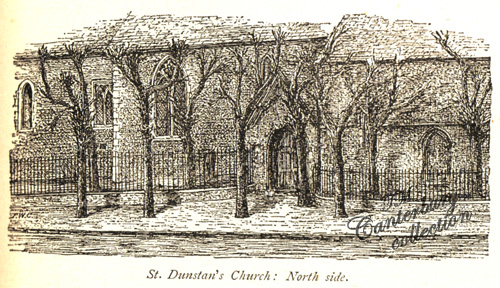
"ST. DUNSTAN'S CHURCH: NORTH SIDE" A drawing from my RROC 1884
St. Dunstan's Canterbury BELLS, weighs 3 tons 10 cwt and was cast 1762. The order was given to Lester and Pack, of Whitechapel, but they found it more convenient to do the work on the spot, than to carry the old bell to London and back again. William Chapman was sent down to perform the work, and he put on the bell the inscription:
Gulielmo Friend S.T.P. Decano
Lester and Pack, of London, Fecit, 1762. Wm. Chapman molded Me*
* "It was while engaged in this business that Chapman saw among the bystanders a young man who seemed to take an unusual interest in the proceedings and he offered to take him back to London, and teach him to be a bell-founder. This was William Mears, and he accepted the invitation, and went to London with Chapman to learn his profession and it is through this incident that the Whitechapel foundry came to the Mears' family."
-------------
Burials in St. Dunstan's - January 9, 1677, John Williamson a prisoner for debt (in the reign of Charles II)
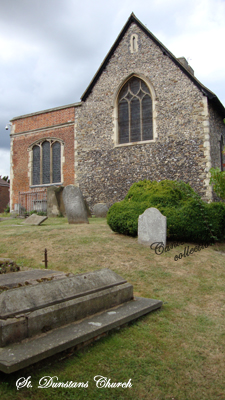
John Roper Esq.
John Roper, Esquire*, of St. Dunstan's Canterbury, 5th April 1487. To Thomas Roper, my son, all my manors of Breule**, Botelar, Tarncourt, and Apperwall, with their rights, members, and appurtenances, in the parishes of Bocton subtus le Blene, Selling, Harnehill, and Feversham, according to a certain deed made by me to the said Thomas, in full satisfaction of his share of my lands, of the tenure of Gavelkind, which might come to my said son by my death, and if this my will had not been made; I will that all other my manors, lands, and tenements, hereditaments, with the reversion of the same, in the parishes of St. Dunstan, Hackington, Stourmouth, Preston, Bocton subtus le Blene, and Holy Cross Westgate of Canterbury, or elsewhere, immediately after the death of Margaret my wife, shall remain to John Roper, my eldest son, and his heirs for ever; Richard Long, Vicar of St. Dunstan's. Proved 11th January 1489, at Canterbury.
Testament Vetusta, 1826
* Apparently John Roper, who was one of the Surveyors of the Cinque Ports, and who married Margery, daughter and coheir of John Tattersall, and was ancestor of the Right Hon. Lord Teynham. ** Query

"ST. DUNSTAN'S CHURCH, EARLY STONE WORK" from J. Cox
Inventories of St. Dunstans, Canterbury 1500 - From The Gentlemen's Magazine 1837 (PDF File)
Archaeologia Cantiana published 1887 - "Accounts of St. Dunstan's, Canterbury"
TERRY CHRISTENINGS AT ST. DUNSTANS
1572, April 8 - Christening, Leaonard TYRRYE
1596(97), Feb. 27 - Christening, Suzanna TERRIE
1606, May 18 - Christening Abigail, d. of Leonard TERRY
1616, June 9 - Christening Ellen, d. of Samuel Baldocke. James Tressar and George TERRY, Churchwardens
1697(98), Jan. 24 - Christening, Ann, d. of James and Martha TERRY
1700, July 28 - Christening James s. of James TERRY, innkeeper, and Martha his wife
1703(04), Feb. 11 - Christening Thomas, s. of James TERRY, inn-keeper and Martha his wife
1763, Nov 13 - Christening John, s. of Isaac and Jane TERRY
1765, May 12 - Christening Barbara, d. of Isaac and Jane TERRY
1767, Feb 15 - Christening Adam, s. of Isaac and Jane TERRY
1768, Dec 18 - Christening Isaac, s. of Isaac & Jane TERRY
1771, May 5 - Christening, John, s. of Isaac and Jane TERRY
1773, Aug. 13, Christening, James, s. of Isaac & Jane TERRY: received 22nd August
1775, Sept. 17 - Christening Thomas, s. of Isaac and Jane TERRY
1778, Feb. 6 - Christening James, s. of Isaac & Jane TERRY
1780, Feb 6 - Christening Jane, d. of Isaac & Jane TERRY
1790, Jan. 31 - Christening Isaac TERRY, s. of George TERRY & Ann HUBBARD. Base Born
TERRY MARRIAGES AT SAINT DUNSTANS
1560, Jan. 16 - Marriage, Thomas TYRRY & Jone CHYTTE DE
1565, July 8 - Marriage, Thomas TERRIE & Joane CHAMBERLAYNE
1566, Nov. 18 - Marriage, Thomas ROBERTSON & Agnes TERRIE
1574, Oct. 13 - Marriage, William KEMPE & Joane TERRIE
1574, Nov. 22 - Marriage, Sylvester TERRIE & Joane TRUSSER
1616, April 1 - Marriage, James STROUD and Eliabeth TERRY, vi facultatis
1625, Feb. 21 - Marriage, Richard STROUD and Elizabeth TERRY
1629, June 30 - Marriage, Robart BRIDGE and Margaret TERRY, vi facultatis
1632, May 27 - Marriage, William TURNER and Rachell TERRY, vi facultatis
1648, July 11 - Marriage, Phillip DETREE and Mary TERRY
1763, June 27 - Marriage Isaac TERRY of Holy Cross Westgate, in Canterbury and Jane HAYLEY
1783, Dec. 24 - Marriage, John TERRY of Brookland, batchelor, and Elizabeth BAYLEY of St. Dunstan, spinster, Licence.
TERRY BURIALS IN ST. DUNSTANS
1560 Aug. 28, Anne TERRIE
1563 July 20, Mary TERRY
1564 July 10, Joane TERRIE
1564 July 16, Agnes TERRIE
1574 April 18, Thomas TERRIE
1575 Mar. 17, Joane TERRIE, Widow
1637 Sept 20, Anne, d. of Arnold TERRY of Feuersham
1638 Mar. 14, Rachel wife of George TERRY
1640 Oct. 16, Leonard TERRY
1769 Mar. 15, John TERRY
1784 Dec. 26, Jane TERRY (John Loftie, Vicar)
1792 Sept. 3, Isaac TERRY, aged 70, from Harbledown
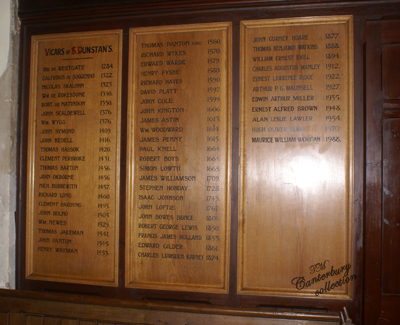
1489 - Richard Long, Vicar of St. Dunstan's
1664 - Paul Knell
1664 - Robert Boys
1665 - Simon Lowth
*Simon Lowth seems to have been non-resident during the whole time he was Vicar. The church wardens presentments during his time are very pitiful reading. Thus in 1666 and 1667 "We have no minster." 1673 "The other churwarden is dead, and wee have not setled Minster." 1674 "Wee have not setled curate there." Simon Lowth became Rector of St. Mildred's Canterbury in 1666, and in the same year he was presented to the living of Holy Cross, also in Canterbury. In 1670 he was made Rector of Harbledown and 1679 he vacated Holy Cross and accepted the living of SS. Cosmus and Damina in the Blean, having apparently resigned the Rectory of St. Mildred's in 1672.
1709 - James Williamson
1728 - Stephen Hobday
1743 - 1767 - The Rev. Mr. Isaac Johnson, Vicar of St. Dunstan (buried in the cloisters) - died March 13, 1767
1767 Rev. John Loftie inducted June 27, 1767 (to 1801)
Mem. (St. Dunstan's) - On Sunday, January 12th, 1800, in the time of divine Service, Henry Ovenden was declared Parish Clerk in the Room
1801 - 1850 - Rev. John Bowes Bunce, Vicar of St. Dunstan's Canterbury *inducted May 16, 1801, died 1850, age 75 *contributed to the Gentlemen's Magazine Dec 1837, signed VSD, (Vicar of St. Dunstan's)
1823 - Rev. J. B. Bunce, Vicar of St. Dunstan's, to the Mastership of Eastbridge Hosptial, Canterbury
"Civil Preferments - Rev. J. B. Bunce, Vicar of St. Dunstan's, to the Mastership of Eastbridge Hospital, Canterbury." The Gentlemen's Magazine 1823\
"Died - Lately, at an advanced age, Charlotte, relict of the Rev. John Loftie, formerly Vicar of St. Dunstan's, Canterbury." The Gentlemen's Magazine 1834
Clergy Deceased - June 15, 1850, at Harbledown, near Canterbury, aged 75, the Rev. John Bowes Bunce, Vicar of St. Dunstan's, Canterbury, Vicar of Sheldwich, Kent, and Master of Eastbridge Hospital, Canterbury. He was of St. John's college, Cambridge, B.A. 1796, M.A. 1799; was collated to the vicarage of St. Dunstan's by Archbishop Moore in 1801 and presented to the vicarage of Shaldwich by the Dean and Chapter of Canterbury in 1818. The Gentlemen's Magazine
1850 - Deaths - The Ecclesiastical Gazette, Rev. J. B. BUNCE, V. of St. Dunstan's Canterbury, Kent
1850 - Robert George Lewis
1853 - 1861 - Rev. Francis James Holland
*son of Rev. James Holland - Bernard Henry Holland, M.A. Trinity College, Cambridge, Equity Draftsman and Conveyancer, a student of the Inner Temple 8 Nov. 1878 (then aged 21) called to the bar 3 May 1882 (eldest son of Rev. Francis James Holland, Ma.A. canon of Canterbury) born 1857
1861 - Rev. Edward Gilder M.A., Rector of St. Dunstan's, Canterbury, Member of the Kent Archaeological Society 1862 Archaeologia Cantiana 1862
The Rev. Edward Gilder, M.A. Canterbury, Secretary for the Local Board Local Board for Canterbury, Journal of the Society of Arts, February 3, 1860
1861 - 1874 - Edward Gilder, Vicar of St. Dunstan's (b. Middlesex)
1874 - Charles Lumsden Karney
1877...1882 - Rev. John Gurney Hoare M.A. & Surrogate, Hours of Service; 10:30 am. 7 pm. thurs. 7 pm.
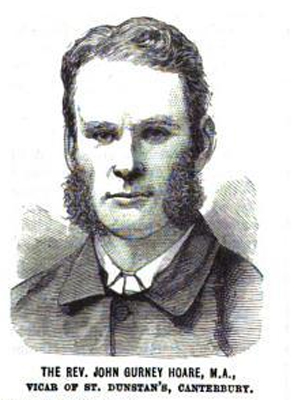
The Rev. John Gurney Hoare, M.A.
DRAWING FROM HOME WORDS FOR HEART AND HEARTH, FROM A PHOTOGRAPH BY ELLIOTT AND FRY
The Rev. John Gurney Hoare, M.A. Vicar of St. Dunstan's, Canterbury, is a son of the well known Canon Hoare of Tunbridge Wells. He was educated at Trinity College, Cambridge, taking the B.A. degree in 1869, and proceeding to M.A. in 1872. He was ordained by the Archbishop of York in 1873, to the Curacy of Christ Church, Sculcoates, Hull, removing after a few months to Sunderland. After two years' work in the northern seaport, he became Curate to his father, at Holy Trinity, Tunbridge Wells, where his labours were greatly valued. In 1877 he was preferred to his present charge, as Vicar of one of the most ancient churches in Canterbury. Here his untiring exertions and faithful preaching have attraced a large congregation, which fills the church at Sunday services. The parish is covered with a network of helpful institutions. The dessemination of pure literature in the homes of the people has a warm friend in Mr. Hoare. He also takes an active interest in Temperance work, and is the President of a flourishing branch of the Church of England Temperance Society. (married 1873 in Tonbridge - Alice Woodfall) *living at St. Dunstan's Vicarage in Harbledown in 1881
1894 - 1903 - Rev. William Ernest Evill B.A. (Trinity Hall, Cambridge), Hours of Service: 10:30 am & 7 pm.; wed 7:15 pm
1913 - Rev. G.A. Manley, vicar

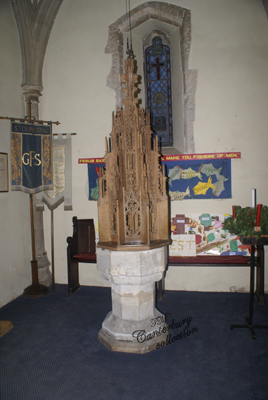 __
__